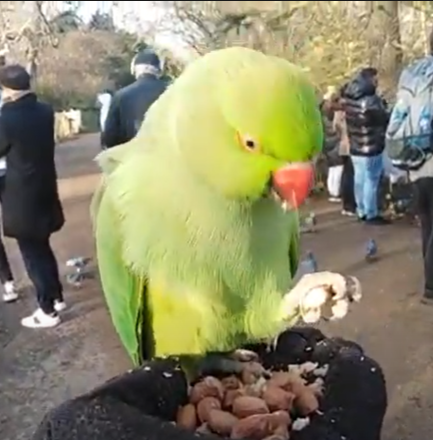| Saturday 30th January, 2021 1.30 to about 3.00pm |
|
| Hyde Park |
|
| Map Travel | |
I will have a small meetup.com badge attached to my rucksack |
|
| Yes 1 |
Maybe 0 |
No 0 |
Hyde Park Parakeet Safari
POSTPONED

Get up close and personal with these friendly, cute and plucky newcomers. The Hyde Park parakeets are very tame. Their favourite foods are shelled unsalted peanuts, sunflower seeds and apples. I will bring a large bag of shelled peanuts to share with you. As for us humans there are a number of café’s open in the park offering take away food and drink.
Obviously this event will depend on government restrictions and the weather. Check back closer to the date of the event.
The parakeets hang out close to the Serpentine (more accurately called ‘Long Water’) just a short distance from the Peter Pan statue when walking from the Italian Gardens. Another way of describing this spot is on the opposite side of the serpentine from the Henry Moore statue. On Google map https://goo.gl/maps/qhWkmez7kiep1Jp29 .
The earliest sighting of a flock of parakeets was in 1855 in Norfolk, and parakeets were also seen in Dulwich in 1893 and Brixton in 1894 so the urban myths about being released from film sets or by musicians as a publicity stunt are somewhat moot. Parakeet numbers rocketed about fifteen years ago, know one quite knows why. They are found mainly in cities, probably because of the availability of an easy meal from garden bird feeders.
Thy are classed as a pest and have damaged grape and apple crops in the countryside. Attempts have been made to control their numbers by shooting but to no avail. They are clever and recognise humans that are likely to do them harm, in some countries farmers have taken to wearing discuses so as to get a clear shot at them. Parakeet numbers are increasing and they are moving north at a steady rate. Originally from the foothills of the Himalayas and southern India (the UK has its own hybrid subspecies) the UK winter is quite mild by comparison.
The Parakeets don’t seem to have much impact on native species but this may change as their numbers grow. One issue is that they roost in their thousands and the noise is intolerable. I had one squawk close to my ear when it was sitting on my shoulder and I estimate it to be in the region of 90db. I can only imagine just how loud a thousand of these rascals can be.